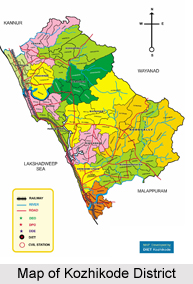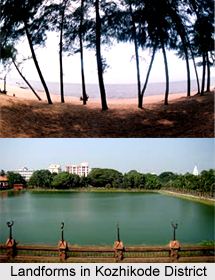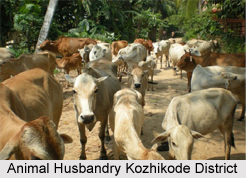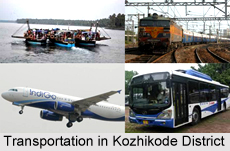 In 1498 Portuguese Navigator Vasco Da Gama discovered Sea Route to India in Kozhikode District. Thus in this way Kozhikode found a place in the World History. Vasco Da Gama landed at the Kappad seashore with three vessels and 170 men. A monument is constructed here to commemorate the historical landing.
In 1498 Portuguese Navigator Vasco Da Gama discovered Sea Route to India in Kozhikode District. Thus in this way Kozhikode found a place in the World History. Vasco Da Gama landed at the Kappad seashore with three vessels and 170 men. A monument is constructed here to commemorate the historical landing.
Kozhikode city continues to be a center of flourishing domestic and international trade. Its contribution to all round development of the district in trade, commerce and economic development over the years is amazing. The development is remarkable and impressive. Kozhikode city is the marketing center for commodities like pepper coconut, coffee, rubber, lemon grass oil etc. These are produced in Kozhikode and the neighboring districts of Wayanad, Malappuram and Kannur.
History:
Calicut is actually derived form Kalikut that was the Arabic for the Malayalam, Kozhikode. It is also called the Cock Fort. According to the historian, K.V Krishnan Iyer, the term Kozhikode is also derived from two words koyil means Palace and Kodu means Fortified. Anyhow, it is a historical town with an old past. From the ancient time the city is attracting travelers year after year. This district has a charming physical features and prosperity. Even today, the glory that was Calicut has not faded. The political history of Kozhikode is a story of unfaithful and ill-conceived conspiracies thought of the Western powers. The history says, Vasco De Gama landed at Kappad in May 1498, as the leaders of a trade mission from Portugal and was received by the Zamorin himself.
However, the history of Kozhikode district as an administrative unit begins from January 1957. When the states of the Indian Union were reorganized on linguistic basis on 1st November 1956, the former Malabar district was separated from Madras state or Tamil Nadu. This was then added to the new unilingual state of Kerala. But malabar district was found to be too clumsy for administrative purposes. Accordingly the state government ordered the formation of three districts. The formation occurred with certain changes in the boundaries of some of the taluks. The Kozhikode district thus came into existence on 1st Jnauary 1957. It was formed of five taluks, Viz, Vadakara, Koyilandy, Kozhikode, Ernad & Tirur. With the formation of malappuram district on 1st June 1969 & Wayandu on 1st November 1980, kozhikode district now consist of one revenue division, three taluks, twelve blocks, 77 panchayats and 117 villages.
Topography:
Kozhikode district is situated on the south west coast of India. The boundary of the district can be mentioned, as on the north there is Kannur district, on the east it is Waynad district, on the south there is Malappuram district while on the west it is surrounded by the Arabian Sea.
Topographically the district has three distinct regions - the sandy, the rocky highlands, which is formed by the hilly portion of the Western Ghats, and the third one is lateritic midland. Of the total area of 2344 sq. km. the sandy coastal belt is 362.85 sq. km. lateritic midland is 1343.50 sq. km. and rocky highlands is 637.65 sq. km.
 The district has three taluks. All of which are spreaded over the three regions. The district has a coastal length of about 80 km. The highland region accounts for 26.80 per cent and the lowland region for 15.55 per cent of the total area of the district.
The district has three taluks. All of which are spreaded over the three regions. The district has a coastal length of about 80 km. The highland region accounts for 26.80 per cent and the lowland region for 15.55 per cent of the total area of the district.
Climate:
The climate in Kozhikode district is very humid with a very hot season and the season extends from March to May. The most important rainy season is during the South West Monsoon, which sets in the first week of June and extends up to September. The North-East Monsoon extends from the second half of October through November. The average annual rainfall is 3266 mm.
During December to march, there is no rain fall in general and from October onwards the temperature gradually increase to reach. It gets the maximum in the month of May. This is the hottest month of the year. The highest maximum temperature recorded at Kozhikode was 39.40 C during the month of March. This was recorded in 1975. The lowest temperature was 140 C recorded on 26th December 1975. Humidity is very high in the coastal region so far.
Malabar Mahotsavam:
This is the most important festival in the Kozhikode district. It is always celebrated with full pomp and glory. It can be said as Malabar, The land of lush green coconut groves and luxurious vegetation is home to many festivals. But the "Malabar Mahotsavam", is the annual tourism festival of Kozhikode. This is celebrated in winter season every year since 1992. This is regarded as the best among the other festivals.
With a view to diminish the gap between the renowned scholars and artists with the common man this Mahotsav was organized. In earlier days this scholars in different disciplines of art and culture of the nation are often inaccessible to the common man. In the year 1992, the Kozhikode District Tourism Promotion Council attempted to give the art loving people and the tourists a unique opportunity to enjoy their performances. Thus, the famous Malabar Mahotsavam was born in Kerala. This was the first attempt of its kind. Now the festival has become the strongest magnet of domestic tourism.
Kalarippayat or the martial art of Kerala:
.
Kalarippayat is the exclusive martial arts heritage of Kerala. It was taken to China by the Buddhist monks, which became the legendary model for the modern martial arts. Kalari Payattu encompasses a revitalizing Ayurvedic herbal treatment for chronic ailments like arthritis and sodalities. It also gives a massage treatment, which repairs physiological damages and makes the body young and supple. The fracture treatment system, developed as a corollary of the rough and tumble world of martial arts. It gives away with the risk-ridden x-rays and hit-or-miss plater-cast method.
Kalarippayat, in literal meaning is `acquired skill` of art. It is mainly derived from two words `Kalari` means school or arena and `Payat` is skill training, exercise or practice. It is the most comprehensive personal combat training scheme anywhere in the world.
 The training includes exercises to develop sharp reflexes for unarmed struggle and techniques of fighting using mace or stick, spears, daggers, sword and shield etc. There is also a unique Kerala weapon that is known as the lethal flexible sword, called `Urumi` which can be concealed as a waist belt.
The training includes exercises to develop sharp reflexes for unarmed struggle and techniques of fighting using mace or stick, spears, daggers, sword and shield etc. There is also a unique Kerala weapon that is known as the lethal flexible sword, called `Urumi` which can be concealed as a waist belt.
Kalri also includes the `marma` treatment that identifies the vital nodal points or marmas in the body. 107 of them are suitable for pressing and pushing to correct muscular and neurological problems. The massaging may involve standing full length over the patient and applying pressure with the feet. The system is acknowledged superior to any other method of massage. But this should always be done by the experts and even a simple mistake can prove as a massive problem in future life.
Administration:
Kozhikode district consists of one revenue division, Three Taluks, 12 Blocks, 77 panchayats and 117 villages. The total area of the district is 2344 Sq. Km., which is in actual accounts for six percentage of the total area of the state. Of the total area of the district, rural area comprises of 2004 Sq. Km whereas 340 Sq. Km. is engaged for urban people. As per the 2001 census, total population of the district is 28,78,498. Total male population is 13,98,674 and total female population is 14,79824. Kozhikode district comprise of two parliamentary constituencies and 12 assembly constituencies.
Government Departments:
Industries: There are some large as well as small-scale industries and different products are manufactured here through out the year.
The different products manufactured here are mentioned below,
Cotton yard and cloth, still billets, hand weaves textiles, soaps, glycerine, scrape iron, tiles and bricks, handloom clothes and bed spreads, curled coir rope, marine products, crum rubber, cattle feed, granite metal products, are some of them.
Fisheries:
Fisheries play a vital role in this district`s economy. The district has a coastal line of 71 km which is spreaded in five coastal blocks namely Kozhikode, vadakara, Chelannur, Panthalayani and Melady. On March the fishermen population in the district was estimated as 107860. Of this, 96067 are marine fishermen and 11793 are inland fishermen. The district has a good marine wealth and large fish catching population. The fishermen mostly rely on the traditional mode of fishing with country crafts and nets.
A good number of country fishing boats are mechanized without board engines. Most of the fishermen still live in poverty. The reasons of their poverty actually lies in different thing like it can happen due to under employment, seasonability in fish catch, lack of organized marketing etc. There are 17 marine fish lending centres with average annual fish lending of about one-lakh matric tonnes. The name of the major fish lending centres are Beypore, vellayil, Puthiyappa, Koyilandy,Vadakara, Kuriyadi and Chombala. There are about 585 registered mechanized boats and 4188 motorized country crafts in the district.
 Animal husbandry and dairy development:
Animal husbandry and dairy development:
The Milk Production of the district is estimated to be 2.47 lakhs tonnes per year. There is also pasteurization plant at Naduvattom run by MILMA with a capacity of 2500 litres of milk per day. 10 Dairy Extension Service units are functioning in the district at Chelannur, Kozhikode, Panthalayani, Thiruvambady, Balussery, Perambra, Puduppady, Payyoli, Vadakara and Tuneri. There are 147 Milk Co-operative Societies in the district. Different veterinary hospitals, clinical labs, etc are also present in this Kozhikode district.
Transportation and communication:
The district has a fairly extensive road network. National Highways run almost parallel to the coastal line linking to Head Quarters of all the three taluks. All the villages in the district are connected with bus routes and the roadways are really markable in the district.
The District has 75.48 km Broad Gauge Railway lines with 18 stations in the district. Railways play an important role in the passenger as well as goods traffic in the district. The double lining work of Railways from Shornur to Managalore is progressing day by day.
Karipur Airport is only 26.5 kms away from Kozhikode City and is located in Malappuram district. With the opening of this Airport, a new area of development is thrown open in Malabar especially in Kozhikode under Tourism. For the development of tourism connectivity takes an important part and this district is fulfilling the process in a successful manner.
The district has fairly well developed network of Post Offices. There are 159 Telegraph Offices and 107 Telephone exchanges in the district.
The Kozhikode station of All India radio has two transmitters namely Kozhikode A of 100 kilowatts power and Kozhikode B or Vivid Bharathi of 1 KW power.
A television transmitter is functioning in Kozhikode relaying programmes from Delhi and Trivandrum Doordarshan with 1000 watts power. Another transmitter with 100-watt power is functioning Kozhikode for Metro channel. Besides Cable TV networks, satellite television are also established in many parts of the district. So it can be said that the district is trying to keep the pace with the new changing generation.
National informatics centers N.I.C.:
National Informatics Centre or NIC is the nodal S&T organization. This is for informatics development and networking in government and public sector for e-governance, decision support, Information Technology development and services. It also provides network and e-governance support to Central Government departments, States or UTs and District administrations in the country.
NIC Kozhikode district Centre is started functioning at Collectorate from June 1988 onwards and since then it became an integral part of District Administration.






